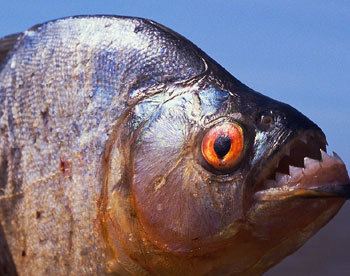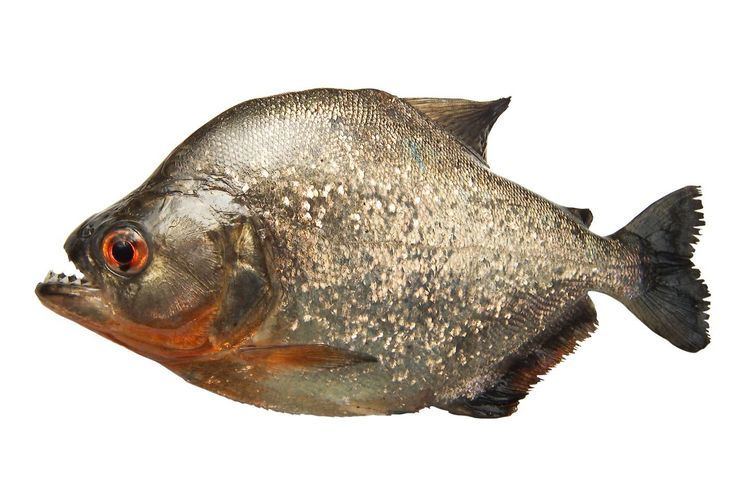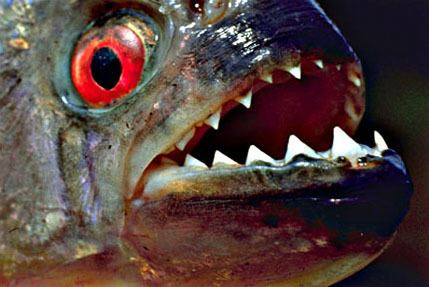Infraclass Teleostei | Phylum Chordata Subclass Neopterygii | |
 | ||
Representative species | ||
A piranha or piraña (/pᵻˈrɑːnjə/, /pᵻˈrænjə/, or /pᵻˈrɑːnə/; [piˈɾɐ̃ɲɐ], [piˈɾaɲa]) is a member of family Characidae in order Characiformes, an omnivorous freshwater fish that inhabits South American rivers. In Venezuela, they are called caribes. They are known for their sharp teeth and powerful jaws.
Contents
- Taxonomy and evolution
- Distribution
- Size
- Morphology
- Biting Abilities
- Ecology
- Relationship with humans
- Attacks
- Legendary reputation
- Theodore Roosevelt
- References

Taxonomy and evolution

Piranhas belong to the subfamily Serrasalminae, which includes closely related omnivorous fish such as pacus. Traditionally, only the four genera Pristobrycon, Pygocentrus, Pygopristis, and Serrasalmus are considered to be true piranhas, due to their specialized teeth. However, a recent analysis showed, if the piranha group is to be monophyletic, it should be restricted to Serrasalmus, Pygocentrus, and part of Pristobrycon, or expanded to include these taxa plus Pygopristis, Catoprion, and Pristobrycon striolatus. Pygopristis was found to be more closely related to Catoprion than the other three piranha genera.

The total number of piranha species is unknown and contested, and new species continue to be described. Estimates range from fewer than 30 to more than 60.
Distribution

Piranhas are indigenous to the Amazon basin, in the Orinoco, in rivers of the Guianas, in the Paraguay-Paraná, and the São Francisco River systems.
Aquarium piranhas have been unsuccessfully introduced into parts of the United States. In many cases, however, reported captures of piranhas are misidentifications of pacu (e.g., red-bellied pacu Piaractus brachypomus is frequently misidentified as red-bellied piranha Pygocentrus nattereri). Piranhas have also been discovered in the Kaptai Lake in southeast Bangladesh. Research is being carried out to establish how piranhas have moved to such distant corners of the world from their original habitat. Some rogue exotic fish traders are thought to have released them in the lake to avoid being caught by antipoaching forces. Piranhas were also spotted in the Lijiang River in China.
Size
Piranhas are normally about 14 to 26 cm (5.5 to 10.2 in) long, although some specimens have been reported to be up to 43 cm (17 in) in length.
Morphology
Serrasalmus, Pristobrycon, Pygocentrus, and Pygopristis are most easily recognized by their unique dentition. All piranhas have a single row of sharp teeth in both jaws; the teeth are tightly packed and interlocking (via small cusps) and are used for rapid puncture and shearing. Individual teeth are typically broadly triangular, pointed, and blade-like (flat in profile). The variation in the number of cusps is minor; in most species, the teeth are tricuspid with a larger middle cusp which makes the individual teeth appear markedly triangular. The exception is Pygopristis, which has pentacuspid teeth and a middle cusp usually only slightly larger than the other cusps.-
Biting Abilities
Piranhas have one of the strongest bites found in bony fishes. Relative to body mass, the black piranha (Serrasalmus rhombeus) produces one of the most forceful bites measured in vertebrates. This extremely powerful bite is generated by large jaw muscles (adductor mandibulae) that are attached closely to the tip of the jaw, conferring the piranha with a mechanical advantage that favors force production over bite speed. Strong jaws combined with finely serrated teeth make them adept at tearing flesh.
Ecology
Piranhas have a reputation as ferocious predators that hunt their prey in schools. Recent research, however, which "started off with the premise that they school as a means of cooperative hunting", discovered they are timid fish that schooled for protection from their own predators, such as cormorants, caimans, and dolphins. Piranhas are "basically like regular fish with large teeth".
Research on the species Serrasalmus aff. brandtii and Pygocentrus nattereri in Viana Lake, which is formed during the wet season when the Rio Pindare (a tributary of the Rio Mearim) floods, has shown that these species eat vegetable matter at some stages in their lives; they are not strictly carnivorous fish.
Piranhas lay their eggs in pits dug during the breeding and swim around to protect them. Newly hatched young feed on zooplankton, and eventually move on to small fish once large enough.
Relationship with humans
Piranha teeth are often used to make tools and weapons by the indigenous population. Piranhas are also popular as food, although if an individual piranha is caught on a hook and line, it may be attacked by others.
Piranhas can be bought as pets in some areas, but they are illegal in many parts of the United States. It is illegal to import piranhas into the Philippines and violators could face six months to four years in jail.
The most common aquarium piranha is Pygocentrus nattereri, the red-bellied piranha. Piranhas can be bought fully grown or as young, often no larger than a thumbnail. It is important to keep Pygocentrus piranhas alone or in groups of four or more, not in pairs, since aggression among them is common, not allowing the weaker fish to survive, and is distributed more widely when kept in larger groups. It is not uncommon to find individual piranhas with one eye missing due to a previous attack.
Attacks
Attacks resulting in deaths have occurred in the Amazon basin. In the city of Palmas, Tocantins, 190 piranha attacks were reported in the first half of 2007. In 2011, a series of attacks in the Brazilian state of Piauí resulted in 100 people being injured. In the state of São Paulo, another attack in the Tietê River resulted in 15 injured people. In 2011, a drunk 18-year-old man was attacked and killed in Rosario del Yata, Bolivia. In 2012, a five-year-old Brazilian girl was attacked and killed by a shoal of P. nattereri. Some Brazilian rivers have warning signs about lethal piranhas. On 25 December 2013, 70 bathers were attacked in Argentina. And in February 2015, a six-year-old girl died after being eaten by piranhas when her grandmother's boat capsized during a holiday in Brazil.
According to one study in Suriname, piranha attacks tend to peak in the dry season when food is relatively scarce and the water levels are lower, leading to heavier than usual concentrations of fish in the water. Fatal attacks are rare, and most attacks take the form of individual nips and bites to extremities such as the feet and hands. Splashing tends to make piranhas more likely to attack, and children are often attacked for this reason.
Legendary reputation
Various stories exist about piranhas, such as how they can dilacerate a human body or cattle in seconds. These legends refer specifically to the red-bellied piranha. A common falsehood is that they can be attracted by blood and are exclusively carnivores. A Brazilian legend called "piranha cattle" states that they sweep the rivers at high speed and attack the first of the cattle entering the water allowing the rest of the group to traverse the river. These legends were dismissed through research by Hélder Queiroz and Anne Magurran and published in Biology Letters. Nevertheless, a study in Suriname found that piranhas may occasionally attack humans, particularly when water levels are low.
Theodore Roosevelt
When American President Theodore Roosevelt visited Brazil in 1913, he went on a hunting expedition through the Amazon Rainforest. While standing on the bank of the Amazon River, he witnessed a spectacle created by local fishermen. After blocking off part of the river and starving the piranhas for several days, they pushed a cow into the water, where it was quickly torn apart and skeletonized by a school of hungry piranhas.
Roosevelt would later present the piranhas as vicious creatures in his 1914 book Through the Brazilian Wilderness.
